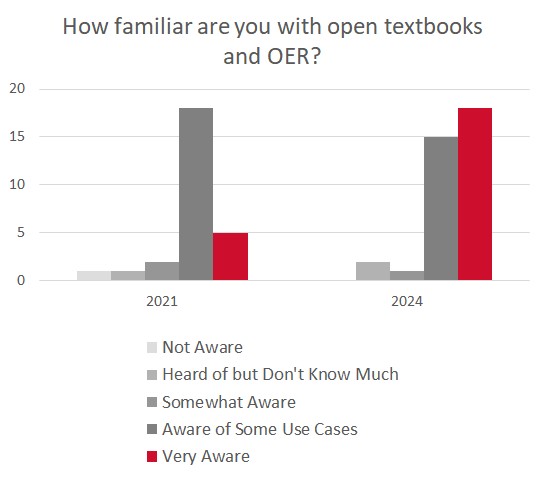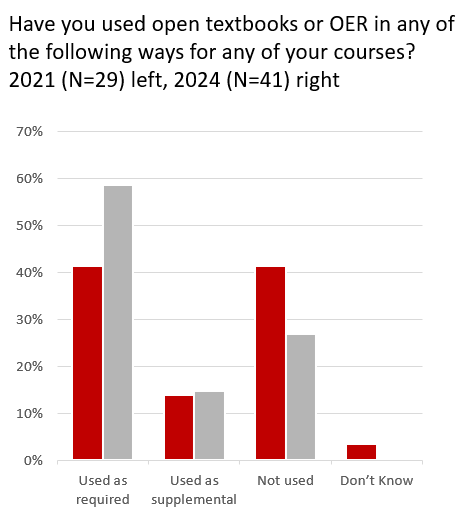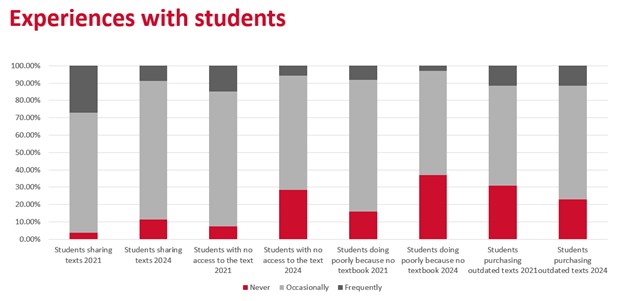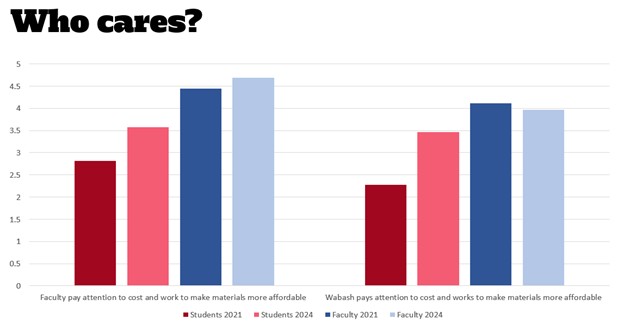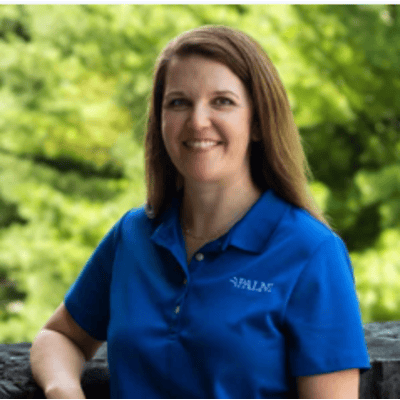Researching the Impact of PALSave: Advancing Affordable Education in Private Colleges
Amanda Hurford and Beth Daniel Lindsay
The Private Academic Library Network of Indiana (PALNI) is a 501(c)(3) owned by 24 private academic institutions. PALNI shares systems and knowledge in many areas, including scholarly communication-focused programs for digital repositories, library publishing, and affordable learning. Its model of deep collaboration pools resources and leverages expertise to expand services available to supported institutions, while containing costs. Through the “Power of PALNI,” each school benefits from reducing the duplication of efforts and achieving more in quality, value, and support.
Wabash College, supported by PALNI, is a private liberal arts college for men in Crawfordsville, Indiana. With an enrollment of approximately 800 students, its mission is to educate men to think critically, act responsibly, lead effectively, and live humanely. Most students come from Indiana, although over 30 additional states and 15 countries are also represented. The team at Wabash’s Lilly Library consists of eight staff members, including the director and archives staff.
The PALSave Affordable Learning Program
Supported by grants from the Lilly Endowment Inc. since 2019, the PALSave Affordable Learning Program is PALNI’s shared textbook affordability initiative. It supports student success and retention by fostering the use of open educational resources (OER) and other zero-cost course materials. The program provides vital infrastructure to increase awareness, education, and engagement across the 24 institutions. Key elements of the program include a centralized support team, faculty stipends, membership in the Open Education Network (OEN), a shared OER repository, and OER publishing/adapting capacity via Pressbooks.
Throughout the PALSave program, PALNI has provided faculty several opportunities to receive stipends and grants to incentivize engagement with OER and other zero-cost resources, each with their own assessment opportunities and challenges.
-
- OER Review Stipends: Faculty were invited to attend educational workshops ending with a call-to-action to write and submit a review for a textbook in the Open Textbook Library. Stipends of $200 were provided to participants. Later, the workshop prerequisite was dropped, and the stipend increased to $300 to encourage greater participation. We also added an additional option of $100 for a brief review in OER Commons or MERLOT.
- Course Redesign Grants: Faculty were invited to apply for a $500 grant to switch from a commercial textbook to a zero-cost textbook or to design a new zero-cost textbook course. Later, the stipend amount was changed to $700 to increase participation.
- Textbook Creation Grants: The program offered competitive grants ranging from $5,000 to $6,500 to individual faculty or teams to write new open textbooks and publish them via the PALNI Open Press.
- Open Pedagogy Assignment Grants: The most recent program implemented was $400 grants for faculty to design and implement renewable assignments in their courses.
PALSave Data Plan
To formulate PALNI’s approach to gathering data to demonstrate need, gauge engagement, and assess PALSave’s impact, we developed a Data Plan consisting of ten research questions split into four categories. For more information about research methodologies, visit the data plan and links to example instruments.
Impact of textbook prices:
- How much money are students currently spending on course materials?
- What is the academic impact of the cost of course materials on students?
Impact of zero-cost textbook adoption:
- How many students and courses are impacted by zero-cost textbooks?
- How much money is the PALSave program saving students?
- How does the use of zero-cost resources affect student study habits and course grades?
- How does the use of zero-cost resources affect drop/fail/withdraw rates?
Perceptions of open textbook quality:
- How do faculty attending PALSave workshops perceive the quality of open textbooks?
- How do students perceive the quality of open textbooks?
Impact of using open pedagogical practices:
- How many students and courses are impacted by open pedagogical practices?
- How does using zero-cost resources affect students’ study habits and course engagement?
Research Project One: Assessing Need
PALSave originated from a 2018 Affordable Education Initiatives Task Force at PALNI. The group was tasked with exploring affordable learning programs at peer consortia and identifying common initiatives that could be implemented at PALNI. One of the first activities identified was joining OEN, sending system leaders to the Summer Institute and Summit, and hosting train-the-trainer events. These important capacity-building activities highlighted local data as a key influencer for decision-makers to understand the need to address textbook affordability, especially at private schools.
Student Textbook Survey
To that end, in Fall 2019, PALNI piloted its Student Textbook Survey with three institutions: Goshen College, Manchester University, and Anabaptist Mennonite Biblical Seminary (AMBS). Based on the Florida Virtual Campus Student Textbook Survey, the study focused on the costs of textbooks and their impact on students. Individual institutions were invited to engage their students in the textbook affordability conversation, gather local metrics demonstrating needs to campus administrators, and illustrate the library’s value by spearheading affordable learning initiatives. The survey was again offered in 2020/2021, and nine more institutions participated: Anderson University, Butler University, Grace College & Theological Seminary, Hanover College, Marian University, Saint Mary’s College, Taylor University, University of Saint Francis, and Wabash College.
A total of 2,504 responses from twelve institutions were collected. The study was approved by the Institutional Review Board (IRB) at Goshen College, and participating institutions were provided with documentation to expedite approval on individual campuses. The Student Textbook Survey was used for research questions (RQ) 1, 2, and 8 from the PALSave Data Plan.
Faculty Textbook Survey
A Faculty Textbook Survey was also conducted in the 2020/2021 academic year to understand textbook selection habits and their impact on students, and to measure faculty awareness of, perception of, and interest in OER (RQs 2 and 7). A total of 85 responses from AMBS, Hanover College, Marian University, Saint Mary’s College, Taylor University, and Wabash College were collected. Again, the study was approved by the IRB at Goshen College, and participating institutions were provided with documentation to expedite approval on individual campuses.
PALSave Student and Faculty Textbook Survey Findings
Data from the 2019-2021 studies suggested that there was a need for an affordable learning program at PALNI schools. The typical respondent to the Student Textbook Survey was a full-time student seeking a bachelor’s degree, who either did not work or made less than $250 a week. The most common response was $201-300 when asked how much they typically spend on textbooks. 95% of PALNI students surveyed used at least one strategy to reduce the cost of textbooks, such as buying used or digital versions. They also experienced common negative academic impacts — nearly 30% had earned a poor grade, and 25% had not registered for a particular course because of the cost of textbooks.
The typical responding faculty member had worked in higher education for over 20 years, teaching three courses and assigning one textbook per course. For them, content and cost were the most important factors when assigning texts. 73% had witnessed their students having no access to assigned textbooks, and 82% believed that the cost of textbooks was a problem. They were typically aware of open textbooks, but had never assigned one. They cited quality, lack of options, unfamiliarity with available options, and time as significant barriers.
Spotlight on Wabash College: Assessing Need
In the Spring of 2021, when the COVID-19 pandemic was still significantly affecting operations, Lilly Library at Wabash College ran surveys for both students and faculty about Open Educational Resources. IRB approval was obtained from Goshen College. Author Beth Daniel Lindsay presented the findings at an annual faculty learning summit held before Fall classes. Both the President and Dean of the College were present for the presentation, in addition to faculty from across the college and many library staff members.
10% of students responded, and 33% of faculty responded. The top majors listed were the following: economics/financial economics, political science, philosophy, pre-law (notably not a major at Wabash, but included as an option since the survey was standard across PALNI institutions), and psychology. These include several of the most popular majors at Wabash, but notably do not include biology or mathematics. Most faculty respondents were long-term employees of the College, with 15-19 years as the most common response. 16 disciplines were represented, with the highest participation from biology, economics, mathematics, and psychology.
63% of Wabash students reported not purchasing at least one required text for Spring 2021. 28% of Wabash students report receiving a poor grade, 8% report failing, and 9% report withdrawing because they could not afford the textbook in any semester.
To save money, Wabash students reported:
- Buying used textbooks
- Purchasing books off campus
- Sharing textbooks
- Purchasing outdated textbooks
Wabash students prefer to read on paper, but value cost savings over format. 97% of Wabash students report spending less than $400 on textbooks in Spring 2021. At the time, Wabash reported that students should budget $950 on books and supplies according to College Navigator (College Navigator – Wabash College, n.d.). Over half of the students who did not purchase a textbook said it was because the book was too expensive.
As a small institution that deeply values teaching and learning, Wabash faculty and administrators (and the author) were particularly troubled to learn that any student reported frequently dropping or receiving a poor grade in a course solely because he could not afford the textbook. Additionally, Wabash has student support funds expressly for needs like textbook purchasing (sometimes delivered as a zero-interest loan, sometimes as a grant), but awareness of this program varies across campus.
Faculty strongly agreed with the statement, “Faculty pay attention to cost and work to make materials more affordable”. Students, on the other hand, did not strongly agree that faculty pay attention to cost, responding to the statement either neutral or agree. While faculty agreed that “Wabash pays attention to cost and works to make materials more affordable: in 2021, students ranked the statement as barely disagreed. In 2025, students were still less enthusiastic than faculty, but they moved closer to ranking as agreed. At the time, Wabash was moving the bookstore vendor from MBS Direct, now Barnes & Noble College, to Akademos. Library staff had served on a task force to evaluate Akademos and other vendors and supported the transition to Akademos (now owned by VitalSource).
Additionally, because Wabash is in the small group of institutions that retain senior comprehensive exams, continued access to texts after classes end is more salient than it would be to students who wouldn’t otherwise review their course materials. The proliferation of renting both electronic and print textbooks is a particular challenge for Wabash students who prepare for these exams that are designed to cover not only their major(s) and minor(s), but also their distribution requirements.
In the faculty survey, the top six barriers to adopting open resources were: lack of options in my content area, quality, lack of familiarity with options, time, lack of supplementary materials, and concerns about copyright. Fortunately, with time, options in various content areas and supplementary materials have improved for many subjects.
Faculty also indicated that the following would help them adopt open content: grants to enable working on developing content, information on where to find materials, assurance of quality from peer review, publishers, etc., help from librarians and instructional designers, and workshops on adopting open content. To respond to this, Beth offered to meet one-on-one or in small groups with faculty, and regularly delivers introductory workshops on open educational resources; more on this is in the next section on assessing the program.
Research Project Two: Assessing the PALSave Program’s Impact
PALNI used a number of additional data collection methods to answer each Data Plan research question and assess the PALSave program. These included the Open Education Network Data Dashboard and several internally developed instruments to track engagement, savings, impact on student success, and faculty and student perceptions of zero-cost course materials/open pedagogy. Data was shared with the granting body and internally across PALNI schools.
Open Education Network Data Dashboard
The Open Education Network (OEN) Data Dashboard tracked workshop attendance, faculty reviews, and adoption intent. Review invitations and reminders were automatically sent to all faculty attending workshops and/or requested to review an open textbook. The review data collected was qualitative, in a narrative response to OEN’s rubric prompts, and quantitative, in the star rating given to the book (1-5). After the review window closed, faculty were sent a short survey asking if they intended to adopt an open text and asking for information on term and course code if “yes” or “maybe” was selected. This instrument helped to assess the participation levels and impact of workshops and OER review stipends, as well as how faculty perceived OER (research question (RQ) 7). OEN later developed the Data Dashboard to track actual adoptions, savings, and return on investment (ROI) after we started our data collection process, so we did not use it for that purpose.
PALSave Course Tracker
The PALSave Course Tracker is an internal tool developed to track the number of courses using zero-cost texts, cost savings, and ROI. The tracker form was sent out each semester to campus representatives and faculty participating in PALSave initiatives. It was required for Course Redesign Grants and collected the course name and number, the cost of the previous textbook, the zero-cost resource used, the number of students enrolled, and how often the course is offered. This instrument helped assess participation levels, the number of students impacted by Course Redesign Grants (RQ 3), and how much money the program saves (RQ 4). Savings calculations were based on the cost of the previous book and the number of students participating. It also calculated ROI by comparing the amount of money invested through grants to the dollars saved per course.
Student Perception Survey
The Student Perception Survey was distributed to students by faculty. When faculty complete the Course Tracker, they can request access to the perception survey to send to students. It was a requirement for faculty participants in the Course Redesign Grants and Textbook Creation Grants to distribute the survey to students. The survey asks about students’ experience with the text, impact on grades and study habits (RQ 5), and perceptions on the book’s quality (RQ 8). Each semester, data is analyzed and reported back to participating faculty.
Student Success Tracker
The Student Success Tracker is a survey instrument for faculty using zero-cost textbooks to provide information on student success metrics and how they compare to previous versions of the course using commercial textbooks. This was required for faculty participants in the Course Redesign Grants. It asked about average course grade, drop/fail/withdraw rate for the course, and comments on faculty perception of student success (RQs 5 and 6). Data was aggregated and analyzed each semester and used to generate impact reports identifying if the change to zero-cost caused better, the same, or worse measures of student success.
Open Pedagogy Assignment Implementation Tracker
The Open Pedagogy Assignment Implementation Tracker is similar to the Course Tracker and was required for faculty participating in the Open Pedagogy Assignment Grants. It collected information on courses using open pedagogy assignments, including the number of students and if the faculty member plans to continue employing open pedagogy (RQ 9). The Open Pedagogy Student Perception Survey is similar to the Student Perception Survey, and was distributed to students via faculty. It was required for faculty participating in Open Pedagogy Assignment Grants. The survey asks about students’ experience with and perceptions of open pedagogy, including impact on grades and study habits (RQ10). Data was analyzed and reported back to participating faculty at the end of the academic year.
While not officially part of the Data Plan, several other data sources were used to paint a picture of how well the PALSave program engaged faculty and supported student success. These include:
- Various data, open comments, and questions collected from faculty in PALSave grant application forms
- Course Redesign Grant participant feedback in the form of survey comments, email, and informal conversations
- Course syllabi submitted by Course Redesign Grant participants, showing which zero-cost resources were selected
- The Open Pedagogy Assignment Faculty Evaluation Survey, providing feedback on the program and learning outcomees
- Pressbooks Google Analytics, indicating views, users, and downloads of Textbook Creation Grant projects
- Kindle Direct Publishing reports conveying how often print textbooks were ordered and from where
- The PALSave Textbook Creation Grant Author Assessment Report, providing feedback on the program, successes, and challenges experienced
- The PALNI Open Press Textbook Adoption Report form, indicating external adoptions and number of students impacted, dollars saved
Spotlight on Wabash College: Assessing Impact
56 faculty members have attended OER workshops from 2019 to 2024. Wabash’s full time equivalent for faculty is approximately 90, so even accounting for natural change with visiting faculty, this is an impressive percentage. Faculty have written 26 reviews, with the vast majority in the Open Textbook Library and a smaller number in OER Commons or MERLOT. 19 courses have been (re)designed to either convert to using zero-cost resources (meaning open or library-provided unlimited access texts) or be offered for the first time with no cost. Three faculty members participated in the pilot open pedagogy assignment program. This year, the text for Rhetoric 101, a wildly popular course taken by over half the student body with a standard syllabus, will move to an open textbook published by PALNI Open Press.
Outreach has evolved over time. Initially, PALNI staff presented the first open textbook workshop to a large cohort of Wabash faculty. After her arrival, Beth presented each semester for several semesters, targeting the session for roughly six weeks before course materials adoptions were due (so that faculty could review textbooks at the same time that they were adopting textbooks for the next semester). With attendance waning, we shifted to once per year, and specifically invited new faculty (and scheduled a different week from the monthly new faculty orientation lunches). Beth has found over time that invitations sent to individuals (often via mail merge, so not actually composed individually) yield greater participation than mass messages.
Independent of the PALSave program, Wabash had three years of funding (also from the Lilly Endowment Inc.) for Equity and Inclusion Pedagogy Fellows. This program is deliberately quite flexible, so faculty in different disciplines approached their courses’ (re)design in ways that made sense to them. Beth served as a consultant to each cohort and, when appropriate, engaged faculty interested in open education either using open educational practices or open and affordable course materials.
Recently, Beth obtained the timetable of scheduled departmental reviews, when academic departments undertake significant reflection on their program, including with outside reviewers. The hope is that contacting departments when they are already rethinking the curriculum will yield interest in open education.
In 2024, and aligned with the plan developed over the course of the Open Educational Resources Librarianship (now Open Education Librarianship) Certificate from the Open Education Network, the Student and Faculty Textbook Surveys were again distributed. Again, initial IRB approval was obtained from Goshen College, but this time, expedited approval was sought from Wabash’s IRB as well.
Approximately 12% of the student body participated and 37% of faculty, a small increase from 2021. The most common majors represented were economics, political science, computer science, and psychology. This is unfortunate that once again, some of our popular majors were not well represented, and especially disappointing that biology did not appear since the biology department moved to open textbooks in several introductory courses between the initial survey and the follow-up. In the future, faculty champions would be identified to discuss the survey in classes and/or set up survey collection points at strategic locations both in academic buildings and the dining hall. Faculty came from across disciplines.
Again, faculty rated the cost to students as one of the most important considerations when choosing a text, followed by comprehensive content. Faculty were much more aware of OER in 2024 vs 2021, with over 30 faculty rating themselves as aware or very aware of OER in 2024 vs closer to 20 in 2021. See the chart, “How familiar are you with open textbooks and OER?”. This is notable especially in the context of Bay View Analytics survey, which recently showed other faculty are less aware (Seaman & Seaman, 2024).
Over half of the faculty respondents had used OER as required course material. See chart, “Have you used open textbooks or OER in any of the following ways for any of your courses?”. Faculty identified similar barriers to adoption in 2024 that they did in 2021, notably quality, lack of options in content area, limits on their time, lack of familiarity with options, and lack of supplementary materials.
Faculty and students reported fewer students were sharing texts, and faculty reported experiencing fewer students without access to course texts or doing poorly in the course due to lack of text. However, more students were buying or renting digital versions and not purchasing texts. See chart “Experiences with students”. Students were also much more positive about faculty and College efforts towards textbook affordability. See chart “Who cares?”. Over 90% of students spend between $0 and $400 on textbooks per semester. Many more students spent under $200 in an average semester compared with 2021: 55% in 2024 vs 35% in 2021.
However, not all the news was good. One student reported that he frequently failed a course because he could not afford the textbook, and three students reported they frequently earned a poor grade because they could not afford the textbook.
Conclusion
By incentivizing the adoption of zero-cost course materials in 417 course transformations across PALNI, the PALSave program has generated $3.3 million in textbook savings for over 53,000 student enrollments while positively influencing their academic success. Using various data collection tools mentioned in this chapter, PALNI was able to paint a picture not only of the need for the PALSave program but also of its impact on advancing affordable education at private colleges. These tools enabled us to address the research questions outlined in our Data Plan, guiding our methodologies and providing a consistent framework for the vast amounts of data collected throughout the six-year PALSave program. Our intended audience for this research was internal — to show local stakeholders how the program was going and prove that we achieved what we set out to in our grant proposal. Our approach was pragmatic, and we focused on collecting data using locally grown tools that were free, easily implemented, and achievable with available resources.
Lessons Learned
Given our pragmatic approach, IRB approval was only sought for the data we knew was likely to be published by the program organizers. However, we have since discovered a strong desire from our community to share stories about student success and engagement beyond an internal audience. This discovery has prompted us to consider revising the methodology for future research to include IRB approval for all surveys, especially those involving students.
Pragmatism also led us to approach student success measures qualitatively, using impressions from faculty rather than strictly comparing sections side by side with grades provided by the institution. As noted in Inside Higher Education, nonprofits often experience lack of access to data needed to study student success (Mowreader, 2025). However, this is another area to explore changing up in future program iterations. Both IRB and institutional data sharing require a significant time investment at the project outset that could be worthwhile to better enable downstream data analysis and sharing of research findings. In the future, we recognize the value of collaborating with departments and individuals with access to data, such as staff in institutional research, early in the process. We plan to explore this approach further in future research.
An interesting aspect of longitudinal data collection is the desire to lock in data collection methodologies early in the program and not change them midstream to maintain data consistency throughout the program. Researchers should review available tools and approaches and consider changing strategies at any point to glean new insights or implement efficiencies. For example, the OEN’s data collection dashboard added robust savings and adoption tracking that we chose not to take advantage of since we had already started the process using our Course Tracker.
A final lesson learned is not to underestimate the sheer amount of time and dedication it takes to collect, store, analyze, and report data used for research on affordable learning programs. We advise researchers to have a plan, staff accordingly, and leverage their networks—building coalitions across librarians, instructional designers, institutional research, information technology, and faculty—to integrate multiple forms of expertise, use shared infrastructure, and collaborate on sustainable OER impact evaluation.
Works Cited
College Navigator—Wabash College. (n.d.). Retrieved May 6, 2025, from https://nces.ed.gov/collegenavigator/?q=wabash&s=IN&id=152673#expenses
Mowreader, A. (2025). Nonprofit Efforts to Support Student Success Lack Data, Public Funds. Retrieved May 23, 2025, from https://www.insidehighered.com/news/student-success/college-experience/2025/03/19/understanding-student-success-nonprofit-work
Seaman, J. E., & Seaman, J. (2024). Approaching a new normal? Educational resources in U.S. higher education, 2024. Bay View Analytics. https://perma.cc/4HVP-7BFZ

